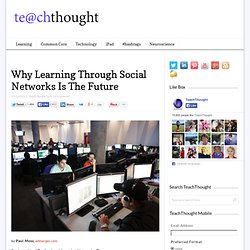

20 Tips for Creating a Professional Learning Network. 23 Resources about Personal Learning Networks (PLNs) Networked Student. A Simple Comprehensive Guide on The use of Personal Learning Networks in Education. Personal Learning Networks, or PLNs, have been around for a long time.

Originally they were your family, relatives and friends, or probably other educators and fellow teachers you work with in the same institution, but now and thanks to the development of web technologies and wireless connections, the concept of PLNs has been expanded to engulf people you have never met before in real world. Much of the learning nowadays takes place online and via a network of interconnected relations. PLNs are basically based on the concept of a learning community. Teachers who are passionate about developing their learning experiences recognize the value of sharing their knowledge and expertise with others. They constantly seek out other learning venues that could be experts in their field or other professionals with whom they can exchange information.They, in short, become a part and parcel of a learning community of like-minded people.
Outline : What is a PLN ? What is a PLN ? Why PLNs in education ? How to Create a Robust and Meaningful Personal Learning Network [PLN] This post describes how educators can develop a personal learning network that supports meaningful and relevant learning.
![How to Create a Robust and Meaningful Personal Learning Network [PLN]](http://cdn.pearltrees.com/s/pic/th/meaningful-personal-learning-49716309)
The MOOC, Education Technology & Media, etmooc, is used here as a working example of how to develop a PLN. “My Personal Learning Network is the key to keeping me up-to-date with all the changes that are happening in education and how technology can best support and engage today’s students.” Brian Metcalfe: teacher, blogger at lifelonglearners.com A visual image of participants in an open, online course- etmooc, which shows the potential to find and create personal connections as part of one’s PLN. (image credit: Alec Couros)
The Educator's PLN - The personal learning network for educators.
Why Communities of Practice die young. I have just been reading a very interesting article entitled The Rise and Fall of a Community of practice: A Descriptive Case Study, by Alton Chua.
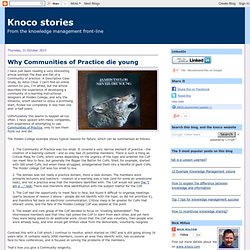
I can't find an online version for you, I'm afraid, but the article describes the experience of developing a community of e-learning instructional designers at Holden College, and why the initiative, which seemed to enjoy a promising start, fizzled out completely in less than one and- a-half years. Unfortunately this seems to happen all too often. I have spoken with many companies, with experience of attempting to use Communities of Practice, only to see them fizzle out and die. The Holden College example shows typical reasons for failure, which can be summarised as follows. 1. 2. 3. 4.
Contrast this with a CoP which I continue to monitor, which started on 1997 and is still going strong 16 years later. That's how you give a Community longevity. How To Teach Online. Yes, still catching up, but getting there slowly but surely.
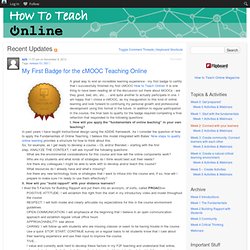
I watched a recording of Jan Herrington’s webinar on designing productive tasks in authentic learning environments. As a reminder, the nine elements of authentic learning: Provide authentic contexts that reflect the way the knowledge will be used in real lifeProvide authentic tasks and activitiesProvide access to expert performances and the modelling of processesProvide multiple roles and perspectivesSupport collaborative construction of knowledgePromote reflection to enable abstractions to be formedPromote articulation to enable tacit knowledge to be made explicitProvide coaching and scaffolding by the teacher at critical timesProvide for authentic assessment of learning within the tasks.
Applied to the wine marketing students I teach: Personal Learning Networks. How Educators Can Make Time for Professional & Personal Development. What better time than the week after Labor Day, the traditional back-to-school kick-off, for educators to embrace opportunities for professional and personal development (PD).

Though for some just the thought of beginning a PD course of any kind is overwhelming, even stressful. The most frequently cited barrier to engaging in extracurricular learning activities is time; not having enough of it, not being able to find it, and wishing for more. Warranted too, given the frenetic pace of our current culture. Why You Need a PLN, and How to Develop One: Resources Shared at #ASTD2014.
At the 2014 ASTD Conference and Expo, I led a discussion titled Why You Need a PLN, and How to Develop One.
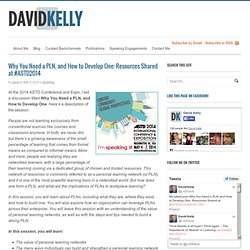
Here’s a description of the session: People are not learning exclusively from conventional sources like courses and classrooms anymore. In truth, we never did, but there’s a growing awareness of the small percentage of learning that comes from formal means as compared to informal means. The Ultimate Student Guide to xMOOCs and cMOOCs. The education media declared 2012 the year of the MOOC, and even mainstream news featured numerous stories about Massive Open Online Courses, some suggesting that this new type of course would revolutionize the model of higher education.
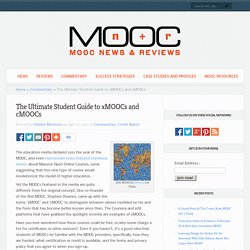
Yet the MOOCs featured in the media are quite different from the original concept. One co-founder of the first MOOC, Stephen Downes, came up with the terms ‘xMOOC’ and ‘cMOOC’ to distinguish between classes modeled on his and the form that has become better known since then. The Coursera and edX platforms that have grabbed the spotlight recently are examples of xMOOCs. Have you ever wondered how these courses could be free, or why some charge a fee for certificates or other services? Even if you haven’t, it’s a good idea that students of MOOCs be familiar with the MOOC providers, specifically, how they are funded, what certification or credit is available, and the terms and privacy policy that you agree to when you sign-up.
‘c’ stands for Connectivist. Why Learning Through Social Networks Is The Future. By Paul Moss, edmerger.com.
